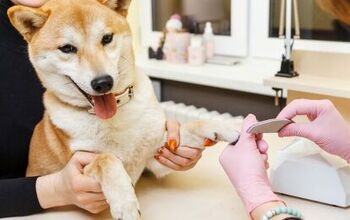With the news of the recent American Bully XL ban in the UK, conversations around dog muzzles have been popping up all over social media. The growing discussion has opened the door for dog owners in the United States to consider the benefits of using a muzzle for their own dogs for many reasons, including scavenging, reactivity, and even short-term use for veterinary and grooming appointments. But with so many different styles of muzzle on the market, how do you choose the best muzzle for your dog? We have you covered! In this guide, we will discuss the different muzzle types available, what each type is best suited for, and the proper fit of a dog muzzle. Plus, I will share which muzzle we currently use with our reactive dog, Lucifer, and why. Let’s get started… Things to Consider When Shopping for a Muzzle for Your Dog When selecting a muzzle for your dog, there is no singular “best option” that will work for every dog and situation. On one hand, this can be frustrating as it leaves you feeling overwhelmed navigating the wide assortment of options. On the other hand, it means you can purchase a muzzle uniquely suited for your dog’s needs. Here are a few key factors to consider when making your decision: MaterialThere are several materials to consider when shopping for a muzzle, including metal, plastic, rubber, vinyl, leather, Biothane, fabric, silicone, and more. To determine the best option for your dog, there are a few critical deciding factors: Do you need a muzzle that can prevent a determined dog from biting? Will your dog be wearing the muzzle outdoors in the elements? Is weight a factor for your dog? Does your dog engage in “muzzle punching” when wearing a muzzle (ramming into people with the muzzle)? Will your dog likely shove the muzzle into the dirt while trying to smell the ground? It is important to note that most muzzles are not considered “bite-proof.” This means they shouldn’t be relied on to prevent a bite from occurring. If you are muzzling as a safety precaution due to a bite risk, the best options are vinyl or wire basket muzzles. Ease of Use Like harnesses and collars, some dogs make fastening a muzzle easy, while others can make the process a challenge. This doesn’t necessarily mean they dislike the muzzle or aren’t properly conditioned to the muzzle. For example, if our boy Lucifer is overly excited about going somewhere, he sometimes gets the zoomies. He usually will stand still to let us buckle his muzzle, but it’s hard to control the zoomies when they hit! A muzzle with a quick-release buckle will be your best option if that sounds familiar. This is faster to secure than a traditional threaded buckle. Airflow One primary concern for those considering muzzling their dogs is the airflow that they will offer, and for good reason! This is especially important if your dog is going to be active while wearing the muzzle. Wire basket muzzles are often a favorite for high-energy dogs, allowing for uninterrupted airflow and making it easy for your dog to drink while wearing it. In comparison, leather and Biothane muzzles, especially those designed to prevent scavengers from being able to pick up “goodies” on their walks, generally limit airflow. Carefully consider your dog’s lifestyle and the situations where a muzzle may be needed.












